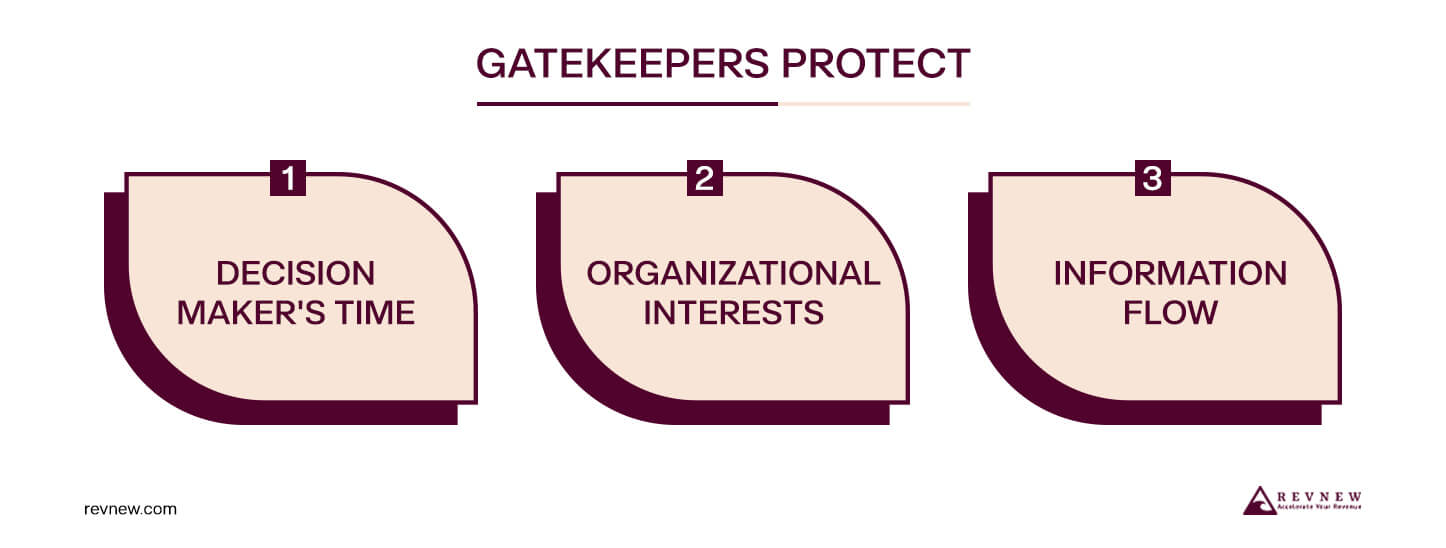
How to Overcome Gatekeeper Objections and Reach Decision-Makers
Do you ever feel like getting to a B2B decision-maker is like cracking a vault? You're not wrong. Studies show only 5% of B2B purchases happen after just one call. That means you need multiple conversations with those controlling the purse strings.
The problem – administrative or executive assistants who act as gatekeepers of the decision-maker's schedule. They stand between you and that crucial meeting.
But here's the good news: you can bypass their objections and schedule those high-value appointments.
This blog post is your roadmap. We'll show you how to:
- Navigate past gatekeepers
- Land meetings with decision-makers
- Decode the path to successful B2B sales conversations
Who Are Gatekeepers? They're Not the Enemy (Just the First Line)
Ever call a company and get stuck in a maze of automated menus and polite but firm voices asking who you are and why you're calling? Those are your gatekeepers. They can be receptionists, administrative assistants, or executive assistants – the bridge between you and busy decision-makers.
What’s Their Role?

Gatekeepers play multiple roles. Here’s a quick breakdown:
1. Checkpoint Keepers: Guardians of Time and Priority
These gatekeepers aren't trying to be annoying. They're protecting the decision-maker's time and priorities. Imagine if every salesperson, vendor, or random contact could get immediate access to a CEO. Chaos!
Gatekeepers act as a filter, ensuring only relevant and urgent communication reaches the top.
2. Information Ninjas: Masters of Flow
They manage the flow of communication, prioritizing emails, calls, and meetings so the decision-maker can focus on what matters most. Picture a desk overflowing with emails and a ringing phone every five minutes – that's what could happen without a gatekeeper!
3. Wheel Turners: Guarantors of Smooth Operations
Gatekeepers are behind-the-scenes heroes who contribute to the smooth operation of daily schedules. They keep things organized and efficient, ensuring a steady workflow within the office.
Imagine lost appointments, forgotten deadlines, and a frustrated decision-maker – all errors might occur minus gatekeepers.
4. Security Guards: Protectors of More Than Access Control
Gatekeepers play a crucial role in upholding company policies and security measures. They ensure visitors have the proper permissions, confidential information stays protected, and company protocols are followed.
True, gatekeepers act as barriers. However, they're also bridge builders. They interact with internal and external stakeholders, and their communication style can influence the company's overall perception.
Plus...
We should not underestimate the power of a good gatekeeper. Experienced ones can become quasi-advisors, providing valuable insights about callers' credibility and intentions. By controlling information and access, they can indirectly influence business decisions.
However, it’s their job to raise objections – ensuring they play all the above roles perfectly. Let’s explore this in detail:
Understanding Common Gatekeeper Objections
As we have established above, gatekeepers exist to shield decision-makers from irrelevant interruptions and information overload.

Here's a breakdown of the common objections they use to achieve this:
| Objection | Reason |
| They're in a meeting (or a variation) | Protects decision-makers time |
| Send an email first | Creates a buffer for assessment |
| What's this regarding? | Filters for importance and relevance |
| Can you just leave a voicemail? | Tests persistence and seriousness |
| The decision-maker doesn't take unsolicited calls | Sets a clear boundary |
| No one is available right now | Avoids immediate engagement |
So, now that you understand these standard objections, you should know how to tackle them. Here’s how:
Conquering the Gatekeeper: Strategies for a Smooth Connection
Gatekeepers are formidable but not invincible. Here's how to prepare and engage with them effectively – to schedule appointments with decision-makers:
1. Knowledge is Power: Research and Prepare
Before dialing, do your homework. Research the company, current projects, and the decision-maker's role and responsibilities. Understanding their priorities will help tailor your message.
Bonus Tip: Look up the gatekeeper's name on LinkedIn – a personalized greeting can go a long way in building rapport.
2. Personalization is Key: Turn the Tables
Use the information you gathered to personalize your approach. Mention a recent company news item or a project relevant to the decision-maker's focus.
*Example:"Hi [Gatekeeper Name], I'm calling [Your Name] from [Your Company]. I noticed [Company Name] is working on [Project X], and I believe our solution in [Your Area of Expertise] could be valuable."
3. Building Bridges: Establish Rapport
Gatekeepers are people too! Treat them with courtesy and respect. Acknowledge their role and express appreciation for their time. Example:
"I understand you're busy, but I would appreciate a few minutes of your time to discuss how we can help [Company Name]."
4. Words Matter: Master Verbal Communication
Speak confidently and clearly. Avoid jargon or overly technical language. Focus on the value proposition you bring to the decision-maker.
Example: "We've helped similar companies in [Industry] achieve [Specific Result] through [Your Solution]."
Showing, Not Telling: Craft Effective Dialogues
Here's a sample dialogue demonstrating a successful interaction:
You: "Hi [Gatekeeper Name], this is [Your Name] from [Your Company]. I'm calling because I noticed [Company Name] is focused on [Project X]. Maybe, we can help.”
Gatekeeper: "[Decision-Maker Name] is very busy. Can you provide more details on this?"
You: "Yes. We've helped similar companies in [Industry] achieve significant improvements in [Specific Metric] through [Your Solution]. Would there be a convenient time to connect with [Decision-Maker Name] to discuss how we can address their specific challenges?"
5. Persistence Pays Off: Don't Give Up Easily
If you encounter an initial objection, don't be discouraged. Be polite and persistent, and offer alternative solutions.
Example: "I understand they're busy. Would it be helpful to send a brief email outlining how we can assist with [Project X]?"
Following these strategies can transform gatekeepers from obstacles into allies. So next, let’s get more specific…
Tactics for Bypassing Specific Gatekeeper Objections
Here’s a breakdown of the strategies you can leverage to address common gatekeeper objections and schedule high-value appointments:
| Objection | Tactic |
| They're in a meeting |
Understand the Timing: Acknowledge their response and inquire about a better time to call. Show respect for the decision-maker's schedule. Propose Alternative Times: Suggest two specific time slots, allowing them to choose or offer another suitable time. Demonstrate flexibility and consideration. Follow-up: If times aren't confirmed, ask permission to send a calendar invite for a tentative time, keeping your name in front of the decision-maker. |
| Send an email first |
Immediately Comply: Agree by email, but use the call to confirm the email address and personalize the message. Mention a specific point you'll expand on in a follow-up call. Set the Stage for a Call: In your email, propose a specific follow-up call, making it easy for them to agree to a scheduled conversation. |
| What's this regarding? |
Give a Clear & Concise Response: Prepare a brief, impactful statement communicating your value proposition. Be specific enough to be interesting but general enough to keep them cooperative. Demonstrate Empathy & Assurance: Show understanding of their role and assure them the conversation will be valuable. |
| Can you just leave a voicemail? |
Show Preference for Direct Engagement: Politely express your preference for a brief live conversation to ensure clear communication and answer questions. Use Voicemail as a Last Resort: If they insist, leave a compelling and concise voicemail with a call to action that encourages a callback. Mention an email summarizing the voicemail for added visibility. |
| The decision-maker doesn't take unsolicited calls. |
Use the Referral Technique: Ask if someone else recommends new products/services. This broadens your entry point while following their rules. Brief on the Credentials: Briefly highlight key achievements or endorsements to boost credibility and potentially shift their perception of the call. |
Strategies are great. However, you cannot do away with tech in this digitally savvy world. So, finally…
Leveraging Technology and Tools: Turn the Tide
Embracing technology helps you become a more competent, efficient salesperson. Here’s how tools can help you streamline your interactions with gatekeepers and reach decision-makers for meetings:
Your Digital Arsenal: CRMs and Scheduling Tools
Modern CRM (Customer Relationship Management) systems are your weapon against wasted time and missed opportunities. These platforms let you record details about each interaction with gatekeepers and decision-makers.
Imagine a treasure trove of information, including:
- Time of Day: Track which times yield the best responses from gatekeepers and decision-makers.
- Approach Effectiveness: Analyze how gatekeepers react to different approaches. What tactics resonate best?
- Personality Profiles: To personalize your interactions, capture personal details about gatekeepers and decision-makers (within professional boundaries)—names, preferred communication styles, etc.
But CRMs aren't the only tools in your belt.
Scheduling tools like Calendly and Doodle integrate seamlessly with emails, allowing gatekeepers and decision-makers to choose meeting times that fit their schedules. This eliminates the tedious back-and-forth of finding a mutually agreeable time, streamlining the process.
Data-Driven Strategies: Analytics for Success
The power of technology doesn't stop there. Call and email analytics can provide invaluable insights to refine your approach:
- Timing is Everything: Analyze past successful interactions stored in your CRM to pinpoint the best days and times to reach out. Call on Tuesday mornings instead of Fridays. Why not?
- Pattern Recognition is Key: Evaluate successful calls and emails to uncover communication patterns.
- Does a specific gatekeeper prefer detailed information upfront?
- Does a certain decision-maker respond better to concise pitches?
Tailor your communication based on these insights for a more persuasive approach.
Conclusion
You can transform gatekeepers from obstacles into allies using effective communication strategies, the power of technology, and data-driven insights. As such, you can be more successful in scheduling meetings with decision-makers who hold the key to closing deals.
Finally, don't let gatekeepers prevent you from achieving B2B sales success! Revnew can equip you with the tools and strategies to navigate past gatekeepers and connect with key decision-makers.
Schedule a free consultation with a Revnew expert to discuss how we can help you streamline your sales process and achieve your goals.




